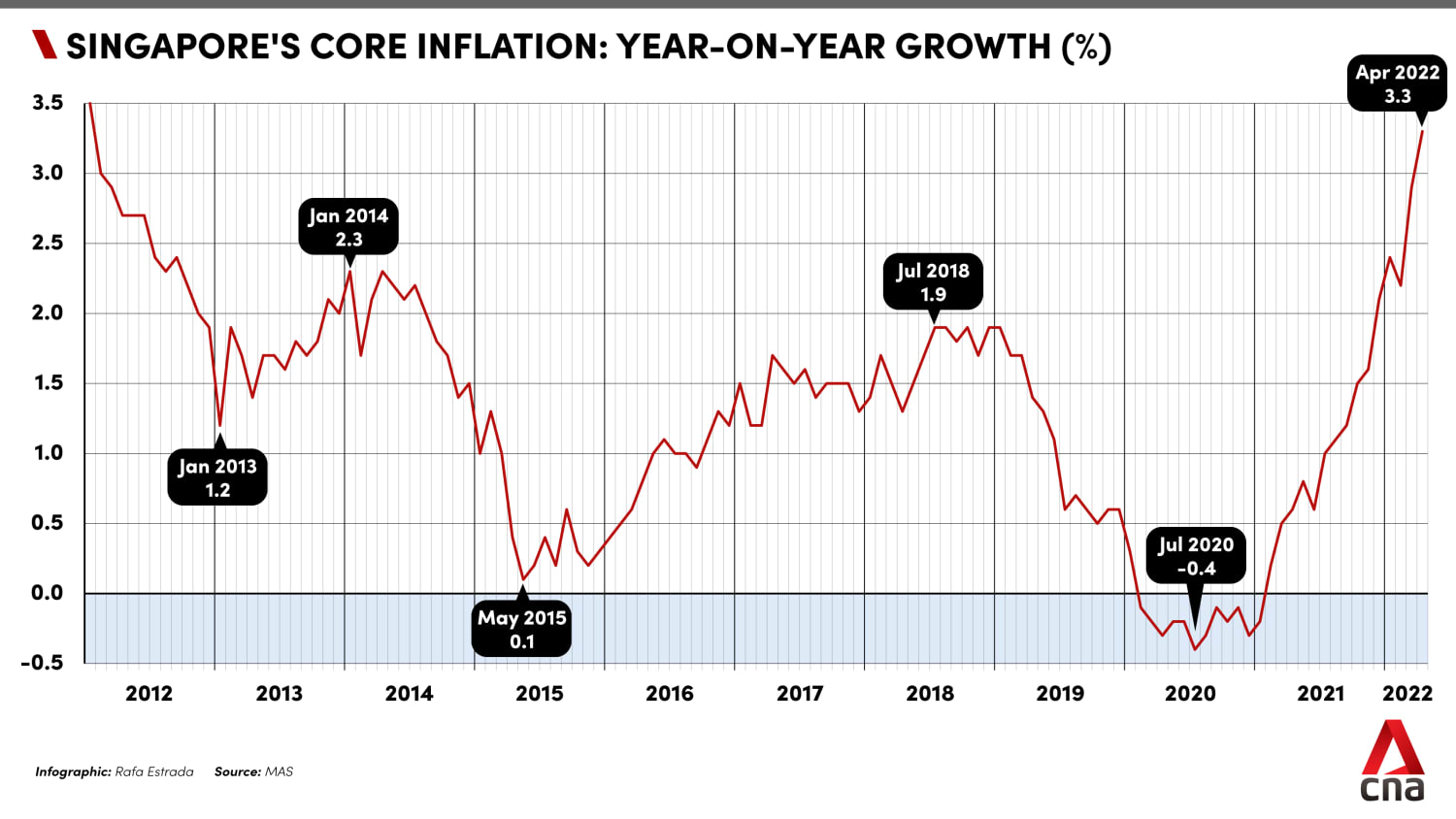Singapore maintains 2022 growth forecast at 3-5%, expects growth to be at 'lower half' of this range
SINGAPORE: Singapore has maintained its full-year economic forecast for 2022 at 3 per cent to 5 per cent but is expecting growth to come in “at the lower half” of this forecast range amid a weaker outlook for external demand.
Official data released by the Ministry of Trade and Industry (MTI) on Wednesday (May 25) showed that Singapore's economy grew at a slower pace in the first three months of the year.
Gross domestic product (GDP) expanded by 3.7 per cent on a year-on-year basis in the first quarter, better than the 3.4 per cent seen in the Government’s advance estimate but much slower than the 6.1 per cent growth in the previous quarter.
On a quarter-on-quarter seasonally adjusted basis, the economy grew 0.7 per cent, also higher than the 0.4 per cent in the initial estimates but pulling back from the 2.3 per cent growth in the preceding quarter.
Growth during the first quarter was mainly supported by the manufacturing, finance and insurance, and professional services sectors.
WEAK EXTERNAL ENVIRONMENT
MTI noted that Singapore’s external economic environment has deteriorated since its last quarterly report in February, partly due to the onset of the Ukraine war which has disrupted the global supply of energy, food and other commodities.
This has, in turn, exacerbated global inflationary pressures and adversely affected the growth of many economies.
In China, stringent measures imposed to combat COVID-19 are also likely to weigh on the country’s economy and contribute to global supply bottlenecks.
“Consequently, global supply disruptions are projected to be more severe and prolonged than earlier expected, potentially persisting throughout 2022. This, in turn, is likely to constrain production and dampen GDP growth in some external economies by more than we have previously projected,” said MTI’s permanent secretary Gabriel Lim at a media briefing.
At the same time, “significant” downside risks remain in the global economy.
Apart from the ongoing Ukraine war, others include a faster-than-expected monetary policy tightening in advanced economies which could lead to disorderly market adjustments and the trajectory of the COVID-19 pandemic.
With that, MTI said the growth outlook for some outward-oriented sectors in Singapore has weakened compared to three months ago.
For example, an economic slowdown in China is likely to adversely affect the prospects of the local chemicals cluster, as well as the fuel and chemicals segment of the wholesale trade sector, given how China is a key market for petroleum and chemicals products from Singapore.
Growth in the water transport segment is also expected to be weighed down by prolonged supply disruptions and port congestions worldwide.
Still, there are sectors which are less affected, such as the electronics cluster that remains supported by robust global demand for semiconductors from the 5G and automotive markets, as well as cloud services and data centres.
Singapore’s move to reopen its borders to fully vaccinated travellers, alongside the easing of travel curbs in regional economies, is also set to boost the professional services sector, as firms in segments like consultancy and legal can now better engage their overseas clients, MTI said.
Similarly, air travel and visitor arrivals are expected to pick up more quickly than earlier projected, thereby quickening the recovery of aviation and tourism-related sectors, entertainment and recreation.
The relaxation of domestic and border restrictions since end-March will also help consumer-facing sectors, such as retail trade and food and beverage services, as well as further alleviate labour shortages in sectors that are reliant on migrant workers, such as construction.
Responding to a question on what might prompt a revision in the growth forecasts, Mr Lim said policymakers have been trying to model the impact of “known knowns”, such as the ongoing Russia-Ukraine war, but there are other “discontinuities” which may be hard to predict.
“At this point in time, we believe our forecast range to be appropriate (and) have flagged that it is likely to come in on the lower half ... but more importantly, there are downside risks so we’ll have to watch that part very carefully.”
Asked for an assessment of the impact of Malaysia’s impending curb on the export of chickens, Mr Lim replied that it would depend on several factors, including how long the ban will last and how quickly Singapore can find alternative sources.
Beyond chickens, disruptions have also emerged in other food and commodity supplies, such as crude palm oil and wheat as producing countries implement export bans.
“Our view is that we may have to gird ourselves for more of such disruptions in the following months,” said Mr Lim, adding that the Government will do its best to mitigate the impact on Singaporeans.
The Singapore Food Agency (SFA) has said it is working with stakeholders, such as importers, to minimise the impact of Malaysia's curb on chicken exports.
This includes stakeholders increasing their imports of chilled chicken from alternative sources or increasing imports of frozen chicken from existing non-Malaysia suppliers.
But MTI noted that it may not be possible to completely shield Singaporeans from the impact of these supply chain disruptions.
“We are small and open. We obviously rely on imports. So I hope that there can be the understanding that in spite of our best efforts, it may not be enough to make sure that there’s zero impact whatsoever," said Mr Lim.
Speaking at the same briefing, the Monetary Authority of Singapore’s (MAS) deputy managing director Edward Robinson said the central bank’s current monetary policy stance remains appropriate.
The MAS has tightened monetary policy three times since last October. The cumulative effects of these tightening moves will slow the inflation momentum in Singapore, he added.
Inflation has in recent months run up to decade-high levels as a confluence of events, such as Russia’s invasion of Ukraine worsening already-frayed supply chains and an ongoing energy crisis.
For the month of April, Singapore’s core inflation, which excludes accommodation and private transport, jumped to 3.3 per cent from 2.9 per cent in March, marking its highest level since January 2012. Headline inflation held steady at 5.4 per cent for the same period.

The central bank has raised its full-year inflation forecasts accordingly. Core inflation is projected to average 2.5 per cent to 3.5 per cent for the year, while headline inflation is expected to come in between 4.5 per cent and 5.5 per cent.
Mr Robinson said on Wednesday that the central bank is keeping to these forecasts at this stage as it monitors price developments “closely”.
He added that inflation outcomes are also a reflection of supply-side constraints and frictions.
“Unfortunately, we have to expect that further shocks of varying nature and intensity may still confront us,” he told reporters.
“Monetary policy cannot deal directly with pure supply shocks ... but the intent is to moderate the pace and persistence of overall price increases which reflect multiple factors at play.”
MAS’ next policy review remains in October, said Mr Robinson, adding that the central bank will be assessing the effects of previous tightening moves, as well as a range of labour market and price indicators.





















